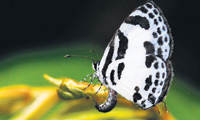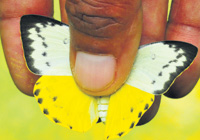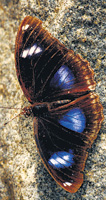
Much more than a flitting passionEnvironmentalist Chitral Jayatilake catches up with Butterfly man Dr. Michael van der Poorten When you hear the name of Dr. Michael George van der Poorten, your mind connects instantly with butterflies, for here’s a man whose life’s passion for these fairy tale creatures goes back more than four decades. His private estate off Wariyapola which spans 40 acres has as its most stunning feature a five acre butterfly garden, packed with larval host plants and nectaring (can this format be used)flowers. The estate has recorded 125 species of butterflies and 97 species of birds, evidence of the ideal habitat that has been created here over the past 20 years.
Arriving in this picturesque setting, you are literally greeted by a myriad of butterflies before you meet Dr. van der Poorten. A gentleman to the core, his pleasing demeanor embodies the man with a deep understanding of both Buddhist and Christian faiths. Dr. van der Poorten graduated from the University of Peradeniya in 1974 with an honours degree in agriculture. He spent the next two years teaching at the University before taking wing to Canada to do his M.Sc and later read for his PhD. He came back to Sri Lanka in 1982 to lecture at Peradeniya but left again for a much longer period during which time he obtained a second degree in computer science. As a software specialist, he worked in Canada in the financial and banking sectors and later as a consultant to IBM, Canada. But a blossoming career could not keep him away from his true passion and he returned to Sri Lanka in 2004. Spending two days with ‘Doc’ (as I call him) at his private estate in Hammaliya off Wariyapola recently, I learnt how his love affair with butterflies began after purchasing a copy of Woodhouse for Rs. 25, way back in 1962. Like many in those days, Michael grew up away from city life where entertainment was scarce. Nature was the attraction and for Michael, butterflies, like myriad floating petals were just too much to resist. He began gathering information from 1962 and even later he spent most of his holidays travelling to different parts of the island recording the habitat, flight periods, distribution, larval host plants and life history of butterflies. He discovered that there are gaps in earlier works including that of Woodhouse where the life histories described for most Lankan butterflies are actually of the Indian species. These descriptions had been accepted without being challenged for the Sri Lankan species. This encouraged Dr. van de Poorten to observe and record local species including their larval host plants, which he feels is pivotal to their conservation.
Four and a half decades of observation has confirmed that many butterflies survive in different environmental conditions such as temperature, relative humidity and light but they cannot change their larval host plants - the plants on which they lay their eggs. Another remarkable finding was that a particular species of butterfly which feeds on a certain plant in the deep south, may not feed on the same plant towards the North Central Province. Area-specific host plants are common in many species contrary to earlier beliefs (e.g. the Common Nawab feeds on Acacia caesia but some southern populations feed only on Albizzia falcatara). In his upcoming book, he plans to also reveal several interesting life histories including symbiotic associations between butterflies and ants for mutual survival. He also explains why butterflies are seasonal and why their numbers can fluctuate so dramatically, sometimes appearing in large numbers and at other times suddenly disappearing. In his book, Dr. van der Poorten also strives to explain why some butterfly species are rare and others more common. The book also identifies species threatened by man’s destructive ways. ‘Doc’ believes that forest dwelling species are dwindling while some of those preferring the open areas are now much commoner. Loss of habitat is the main reason for the decline of some populations of butterflies. Dr. van der Poorten decided to publish this wealth of information in 1997. “I felt I had a great deal of new information hitherto unrecorded that should be shared with those who are interested,” he says. The book is fundamentally about butterflies and their lives. He hopes to portray all the butterflies in Sri Lanka, both male and female including the upper and lower views.
His charming wife Nancy, an honours graduate and software engineer travels with him through the island gathering data. Nancy, he says, has been a great source of inspiration and support over the years. His immense contribution to the field came to light recently with his discovery of a new species of butterfly in Sri Lanka, “Catopsilla Syclla”, many thousand miles from its original country. For the past 15 months he has been setting up butterfly gardens in many Keells hotels while also working with the Wildlife and Nature Protection Society (WNPS) establishing 100 butterfly plots around the island where he is a great hit with children who cannot have enough of his animated descriptions. I asked him what his dream is and there seems a touch of sadness in his eyes as he said he wishes to see a Butterfly Group in the island similar to the Bird Group with members from various ecological zones gathering information. It is time to leave “Hammaliya”. As I bid farewell to ‘Doc’ and Nancy, it is a bright and sunny day. “How was the morning,” I ask him and he replies in his inimitable way “The butterflies are flying.” Dr. Michael van der Poorten’s website is www.srilankaninsects.net |
|
||||||
|| Front
Page | News | Editorial | Columns | Sports | Plus | Financial
Times | International | Mirror | TV
Times | Funday
Times || |
| |
Reproduction of articles permitted when used without any alterations to contents and a link to the source page.
|
© Copyright
2008 | Wijeya
Newspapers Ltd.Colombo. Sri Lanka. All Rights Reserved. |


